Few historians today would quibble with the idea that the war against Nazi Germany was necessary. Japan, Hitler’s only major ally, has fared far better with many historians in the West—much better than in Imperial Japan’s former Asian colonies. Because the war ended with the atomic bomb, many in the West today look at the Pacific War in terms similar to what was called “moral equivalence” in the Cold War. That view shows disregard for the nightmarish world that existed during total war. As World War II passes into history, two fundamental points are essential for understanding the Asian-Pacific War. First, Japan started the Pacific War as the last stage of a long drive to gain Asian hegemony. Second, the Asia-Pacific theater’s violence, only equaled on the eastern front, resulted primarily from the way Japan’s leaders chose to fight and the battle ethos infused in their fighting men. The discussion of these points is not meant to remove from the historical record cruel and often unnecessary violence on the part of the countries fighting Japan but should make the actions of these countries more understandable.
Japan’s War for Empire
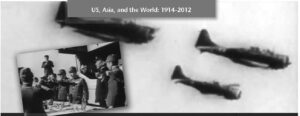
Briefly and bluntly put, Japan started World War II in Asia. The decision to do so was the final act in a steady stream of aggressive moves by Japan intended to create an empire that would rival any in history. Both Japanese modernization and expansionism were inspired by the shock of nineteenth-century European imperialism. To survive and eventually prevail, Japanese elites largely recast society. Universal conscription, universal education, and a breakneck attempt to industrialize transformed Japan within a generation. Additionally, Japan viewed the harsh and often cruel politics of imperialism through a different lens from that of Western powers. The “Great Game” in China was a world away from Europe but on Japan’s doorstep, and imperial forces joined the game rapidly, skillfully, and seriously. By 1905, victorious wars with China and Russia gave Japan possession of Korea, Formosa, parts of Manchuria, and interests in China. Japan joined the allies in the First World War and occupied most of Germany’s Asian possessions, thus expanding its China holdings and projecting its naval power deep into the Central Pacific.
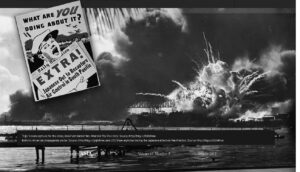
Japanese imperialism from the outset showed an unequaled resolve. Most European countries were finding the “White Man’s Burden” cost more than it gained. In contrast, the Japanese did their utmost to integrate imperial holdings into their growing economy. Japanese control of Korea’s and Formosa’s (now Taiwan’s) economy was deep and intended to grow deeper as Japanese immigrants steadily arrived. The few people from the empire—mostly Korean—who were allowed to work in Japan had a second-class status. From the outset, Japan viewed its holdings in China and Manchuria as potential keys to dominance in Asia. In 1915, Tokyo presented the nascent Chinese Republic with demands that, if accepted, would have given Japan near-sovereign rights in China. Japan overreached, but the intent was plain and bitterly remembered by the Chinese. The Japanese came to stay and always wanted more. If Japanese imperialism had a European parallel, it was that of Czarist Russia.
It is informative to compare the entry of Japan onto the stage of Asian power politics with that of the US since they took place almost simultaneously. After demolishing the Spanish Empire, the US took possession of the Philippines. Elated by success at sea, the US increased its naval power but kept its standing army small. However, the imperialist experiment in the Philippines failed. After a short and violent rebellion, the US displayed a kind of benign neglect toward its only major colony. Investment and trade were insignificant, and administrative costs were high. In less than a generation, the US gave the Philippines home rule and promised independence. More typical of American-style power politics was the Open Door policy that called for international respect of Chinese territorial integrity and free access to markets and resources. In one form or another, the Open Door was American policy until Pearl Harbor.
For a brief period after World War I, it appeared that perhaps Japan was going to allow multilateral diplomacy tempered with liberal values to be a part of its future. Male suffrage was greatly expanded, and party politics became important in shaping policy. Realizing that a naval race with the US was folly, Japan signed a naval arms limitation with the US and Britain in return for recognition of their empire as it existed in 1921.
The flirtation with liberal democracy was short-lived, thanks in part to a large number of secret ultra-nationalist societies of military men or their supporters, which stressed the duty owed to the emperor and the importance of empire. The dark side of the Western scientific revolution influenced Japanese nationalists. Social Darwinism, eugenics, and “scientific” racialism had followers in Japan. Most important was the geopolitical argument that the future belonged to a handful of very large world powers that were self-sufficient “autarkies.” Influenced by these notions, extreme nationalists in the military began a series of assassinations of government officials, aimed at purging Japan of weak and corrupt civilians viewed as barriers to the realization of Japan’s imperial destiny. By 1940, Japan was officially a one-party state under military rule—a situation accepted by Emperor Hirohito.
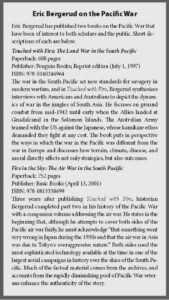 The men that crippled Japanese civilian government started the Asia-Pacific War. In 1931, the army capitalized on China’s political chaos and more than doubled the size of the empire by seizing resource-rich Manchuria, a territory larger than modern Germany. Criticized from many foreign corners over this blatant violation of the 1921 Four Power Treaty, Japan left the League of Nations and abandoned the naval limitations five years later. Although forced to accept the Manchurian humiliation, every Chinese nationalist intended to return to the issue when stronger.
The men that crippled Japanese civilian government started the Asia-Pacific War. In 1931, the army capitalized on China’s political chaos and more than doubled the size of the empire by seizing resource-rich Manchuria, a territory larger than modern Germany. Criticized from many foreign corners over this blatant violation of the 1921 Four Power Treaty, Japan left the League of Nations and abandoned the naval limitations five years later. Although forced to accept the Manchurian humiliation, every Chinese nationalist intended to return to the issue when stronger.
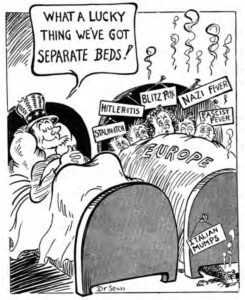
Source: Dr. Seuss Goes to War: The World War II Editorial Cartoons by Theodor Seuss Geisel, by Richard H.
Minear. ©1999 Richard H. Minear, 31. Also see the essay “Dr. Seuss and Japan, December 1941” by Richard H. Minear that appeared in EAA 4, no. 3.
The wait was not long. While creating “buffer zones” around the puppet state of Manchukuo, Japanese forces skirmished with the Chinese near Beijing in 1937. Greatly misjudging Chinese reactions, the Japanese thought a quick military blow would restore order. Instead, the Chinese reinforced, leading Japan to attack and seize Beijing and surrounding areas. Chiang Kai-shek decided to risk a major war, and serious fighting started near Shanghai. The army assured Tokyo that a campaign of three or four months would bring Chiang to heel. Instead, Japan found itself in a costly yearlong offensive that left the empire vilified by other nations, stretched its military badly, and did not defeat China. Pressure increased in 1938–39, when Japan lost border skirmishes to Soviet forces along the Manchurian border.
By 1939, Japan was in a dangerous quandary with no obvious road to victory. China was not going to make peace without a complete Japanese withdrawal, and the military realized that a defeat abroad seriously threatened its and perhaps the emperor’s power. Then, like a deus ex machine (god from the machine), Hitler’s war began in Europe, and the world changed. Tokyo now looked at the Chinese quagmire as a possible gateway to World Empire.
Japan and Germany never coordinated their efforts, but the Pacific War is impossible to understand without realizing its intimate link to events in Europe. Germany’s astounding victory over France in 1940 removed the French from Asian politics, and the Japanese were convinced that Germany would bring England to its knees. Japan joined the Axis in July 1940. Even larger opportunities appeared when Hitler attacked the USSR in 1941. Confident of German victory over Russia, a great imperial dream suddenly appeared obtainable. The dream was what the navy called the “push south.” Despite its imperial gains, Japan remained too dependent on crucial imports, especially with 80 percent of its oil coming from the US. Conquering oil-rich Southeast Asia would solve that problem, possibly force China to the peace table, and leave Japan completely dominant on the continent.
Serious contingency plans for the move south began in January 1941. The big question was what to do about the US. Some military leaders argued that the US would not fight for the British Empire. Others contended that Manila Bay lay astride the communication lines between the Indies and Japan and must be attacked. This decision was approached with the utmost care. The US, also shocked by the events of May 1940, had already begun rearming. The question was how the US might use its new military power if Hitler managed to organize all of Europe’s resources, including, perhaps, the British fleet and turned toward the Atlantic. Perhaps the US would be forced to fend off Hitler, but the Americans might let their forces loose in the Pacific. Although Tokyo realized they could not then conquer the US, if the Americans were ejected from Southeast Asia, Japan could build a string of naval and air bases that would protect the empire and the home islands. If hard-pressed by Hitler, Tokyo hoped the US would cede their unimportant position in Asia to concentrate on the Atlantic threat. In July, the Japanese Army decided that pickings in Soviet Siberia would be easier in 1942—after the Soviet state was driven from Europe or destroyed. Hence, they, too, urged the move south. Japan realized war with America and its allies was a serious gamble, but the prize was great, and the alternative was the end of the empire and perhaps the political system that sustained it.
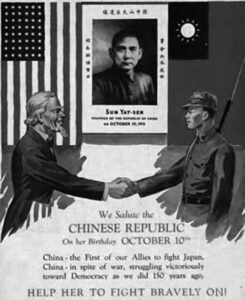
It is important to outline American pre-1941 Sino-Japanese War policy. Although US public opinion was anti-Japanese because of the war in China, American military power was weak before 1939, and isolationism was very strong. Businessmen during the Great Depression were glad to sell oil and industrial materials to a willing buyer. Japan’s war with China would have been impossible without American imports. By 1941, much had changed. US isolationism was still very powerful, but the nation was rearming and had begun Lend Lease. The idea of an anti-American German coalition caused near panic in Washington in 1940, but by mid-1941, the American leaders were beginning to catch their breath. What Tokyo did not know with certitude was that the US government was not going to allow a Japanese conquest of Southeast Asia. The US did not want a Pacific war, and all planning was based on a “Europe First” strategy. When put to the test, the decision was made that war was preferable to Japanese hegemony throughout Asia.
The test came in July 1941, when Japan occupied southern Indochina—an action clearly intended to support a strike into Southeast Asia. Although realizing the danger of war, Washington froze Japan’s assets and established a total trade embargo. The move was decisive, although both sides hoped the other would blink and war would be averted. However, periodic talks lacked a sense of reality. By September, US intelligence was telling FDR that Russia might survive Hitler’s attack. Consequently, the US stuck to a hard line that included a Japanese withdrawal from China. For their part, the Japanese had no intention of retreating from China or making any concession that would interfere with dominance in Southeast Asia. The crisis ended when Japanese planes attacked Pearl Harbor two days after the Soviets launched a brutal counterattack against Hitler’s Wehrmacht outside Moscow.
The Sino-Japanese War of Annihilation
Given Hitler’s defeat, Japan’s great gamble was certain to fail, and the military history of the Pacific War was a question of not if, but when and how, the US and its allies would triumph. When military buildup was adequate, the US was able to fight two major wars on opposite sides of the globe. Military operations in 1943–45 were a kind of military mugging with Japanese efforts increasingly futile. Trapped in a hopeless war and incapable of even imagining a way out, Japan fought with unusual desperation and cruelty in both China and the Pacific.
The military history of the Sino-Japanese War is not well-known in the West because, for the most part, it lacked the big military campaigns of Europe. Yet possibly the blood tax paid by China was close to that paid by the Soviet Union. Ultimately, the Sino-Japanese struggle became so violent because it developed into the largest insurgency ever fought, and serious students of war know that insurgencies are relentless, painful, and very bloody.
The Japanese were guilty of the numerous crimes for which they have received attention. Their soldiers often raped and pillaged. They used chemical and biological warfare. The many instances of Japanese air raids on cities had no objective beyond terror. Some responsible estimates put Chinese civilian deaths in air raids at nearly 300,000—about the same number of Russian civilians killed by the Luftwaffe and not much smaller than the 450,000 Japanese civilians killed in American raids, but in China, this was “small change” when quantifying violence.
Many Chinese battlefields were bloody, but much more killing took place in the countryside. After Japan’s initial offensives, the Imperial Army lacked the resources to go further. There were no defined lines in the Sino-Japanese War like the kind found in Europe. Japan held most of the major coastal cities. Thinly stretched Japanese forces occupied strategic points but not the countryside. The northeast front was larger, but here, too, the Japanese lines were very porous. Even though it was impossible to drive out the Japanese, Chinese forces could sustain a low-level insurgency on any part of the front. By 1939, the situation was clear to the Japanese, and it grew worse when the Chinese Communists saw the advantages of establishing “liberated zones” behind Japanese positions. American aid allowed a slow buildup of an organized Chinese Army. Faced by Chinese insurgents and troops, Japanese soldiers perished at a low but steady rate over six years.
The only response for the Japanese was to launch constant counterinsurgency sweeps through enemy-controlled areas, killing large numbers of civilians and insurgents in each operation. The Japanese formed bands of Chinese mercenary auxiliaries, who often proved even more deadly than Japanese troops when unleashed on a Chinese village. In turn, if the collaborationist troops had families in the area, they became targets for the insurgents. If a collaborating soldier’s mother was killed, another one of her sons might join the Japanese for revenge. As in every insurgency, irregular warfare served as the perfect cover for murderous banditry. Dead people in the street were a common occurrence, and any crime investigation was unlikely.
As is well-known, Japan mistreated Western POWs, but over 60 percent of Western prisoners lived through the war—a percentage considerably higher than found in German camps holding Soviets. Because of the Bataan Death March and the mistreatment of Commonwealth POWs and Filipino civilians, several Japanese officers were executed after the war, including Generals Homma and Yamashita. The larger question of POWs in the Sino-Japanese War cannot be dealt with precisely but possess chilling implications. As shall be seen, Japanese soldiers rarely surrendered, yet over 40,000 were in Allied hands by 1945. After the war, Japanese civilians in Manchuria were repatriated, but there is no evidence that either China or Japan repatriated any military prisoners. It is possible that prisoners of war were rarely, if ever, taken during Sino-Japan hostilities. Although the numbers are uncertain, Chinese estimates of 20 million civilian and military dead must be taken seriously. Contemporary estimates of Japanese military casualties put one million dead and another million seriously wounded. Assuming Japanese numbers are accurate, as many Japanese soldiers died in China as they did battling the US and its allies.
The US-Japan Pacific War
The Pacific War between the US and its allies with Japan developed into a different kind of war of annihilation. The extremely low number of prisoners taken best illustrates the grim nature of the Pacific War. Only 45,000 Japanese servicemen surrendered during land operations in the Pacific War, but over one million Japanese died in battle. In other words, for every Japanese soldier that surrendered, nearly twenty-five were killed. In comparison, in Northwest Europe, both Britain and US ground forces lost one prisoner for every two men killed. The real ratio of Japanese killed to taken prisoner is actually more grim, as over half of soldiers captured were taken in areas like New Guinea that were long bypassed, and some Japanese units collapsed because of famine and tropical disease.
The most common explanation of the exceptional bloodshed during what John Dower called the “War without Mercy” is racial hatred between the Japanese and Americans. According to Dower’s account, racism in Japan receives a share of the blame, but deeply ingrained Western racism, as manifested in the US, is considered at least equally culpable. Not only did America have a long history of racism at home, US immigration laws prevented most Japanese immigrants, and the American government incarcerated some 110,000 Japanese civilians living on the West Coast, 80 percent of whom were citizens. No one can deny the miserable racial relations in the US before World War II. No one can dispute the ugly propaganda campaign launched against the Japanese during the war. However, this situation, although deplorable, does not explain the bloodbath in the Pacific War.
One objection to the racism argument is rarely made but should be self-evident. If murderous combat in the Pacific was generated by American racial attitudes toward Asians, it is very difficult to explain why US forces took huge numbers of POWs in the much-smaller Korean conflict when operating under the same rules of engagement found in the Pacific War. In Việt Nam, Americans captured enemy combatants in numbers that dwarfed those of the Pacific War. If any great racial enlightenment took place in the USA between 1945 and 1950, I cannot identify it.
I doubt ethnic calculations had much impact on young American combatants. Like today, most eighteen- to twenty-year-old Americans in 1941 were apolitical. In interviews that I have conducted with 200 Pacific War combatants, almost all expressed retrospective hatred, and many admitted that the hatred had not totally cooled over the half-century. However, a substantial number of interviewees indicated never meeting a Japanese or Japanese-American prior to military service; they also admitted almost no knowledge of Japan. Pearl Harbor changed this situation overnight, but my view is that that these men learned their hatred not at home, but on the battlefield.
American service members in 1942 lacked any systematic political indoctrination. Prior to Pearl Harbor, political indoctrination within the armed services was forbidden, and afterward, there was little need for it. The young men that swamped recruiters after December 7 received the most cursory of training before being sent to places like Guadalcanal. Among men who needed small arms training, there was no time for systematic political indoctrination. By the time the US government, ably aided by Hollywood, did create a formidable propaganda machine, the Pacific battlefield was already poisoned by bitter experience learned in cruel engagements with the enemy.
To understand this violent dynamic, it is important to know how surrender functions in war. Almost every army in the world accepted the concept of surrender. Even imperial forces took prisoners who wore Western uniforms—evidence of tacit recognition that, when killing becomes separated from military purpose, it becomes either murder or suicide. Taking prisoners also stemmed from powerful self-interest. If a soldier knows the enemy takes prisoners, he is far more likely to give up—but he will fight to the end if he thinks death is certain. Most armies wish to end battles as quickly as possible with minimum losses and welcome surrender. They realize, however, that this is a reciprocal relationship. If one side takes prisoners, so must the other.
In practice, surrender is always dangerous. Surrender is much safer if it is done by several people at once and with some type of prearrangement. Once fighting starts, the situation changes drastically. If much blood is spilled, the battle ethos in the real world allows men to take retribution. If one side commits atrocities, chances for safe surrender decline greatly, so surrender protocol is an imperfect pact. It is done to avoid mutual violence and breaks down in the midst of bloodshed. Killing the helpless is true of all wars and not unique to the Pacific.
The Japanese soldiers were remarkable in their willingness to accept orders that meant certain death and their refusal to surrender. To what extent the Japanese soldier’s willingness to recklessly embrace death reflected something deep in Japanese culture I will let others judge. However, it is undeniable that a Japanese youth in 1941, unlike his American counterpart, had been subject to intense military indoctrination in both school and the larger society. Beginning in the Meiji era, the propaganda barrage was present in some form and reached a fever pitch in the 1930s. Relentless indoctrination imbued every Japanese soldier with a kind of ersatz bushido that bound the individual to the state and glorified death in battle as the supreme act of sacrifice and spiritual purification. Today, we think of the kamikaze attacks when assessing military suicide in the Pacific, but the practice was universal throughout the land war. Knowing that soldiers would hold a position until death was a great tactical advantage, and Japanese officers employed this ethos from the outset to compensate for their lack of mass firepower.
As the first American expeditionary force of the Pacific War headed to Guadalcanal, rumors—later proven true—were already circulating of Japanese cruelty in the Philippines and on Wake Island. Officers were also telling their young soldiers that the Japanese did not surrender. Japanese victories had also given American soldiers respect for the fighting skills of their enemies. Thus, fear was also added to the brew.
Dire predictions of a brutal war proved true in America’s first two Pacific campaigns—Guadalcanal and Buna-Gona. In both of these campaigns in the fall and winter of 1942–43, an alarming pattern developed. The Japanese forces showed astounding courage during both the attack and defense, but Japanese tactics—that relied heavily on the fanatical spirit of the individual infantryman—ultimately proved wanting in the face of Allied fighting skill and superior firepower. Japanese soldiers fought with courage and fanaticism in the Solomons and New Guinea, inflicting serious losses and costing the Allies valuable time. Unfortunately, at the end of both battles, this courage disintegrated into a waste of lives, most of them Japanese. Suicidal banzai charges became a staple in the Pacific. In other instances, Japanese units who fought tenaciously for weeks simply broke down, and men wandered about, shooting into the air or dropping hand grenades at their own feet. What made this type of incident so wretched is that organized units that had clearly lost a battle were in the best possible position to raise a white flag. American officers were eager to take prisoners for intelligence, and organized surrenders would have been accepted. Instead, Japanese soldiers chose death. As the war progressed, these fearsome incidents increased in size and ferocity. Among the most horrid examples are the Cliffs of Death on Saipan, the Meat Grinder on Iwo Jima, and the Suicide Caves on Okinawa. Every American soldier that witnessed such tragedies learned for himself that the Japanese did not surrender.
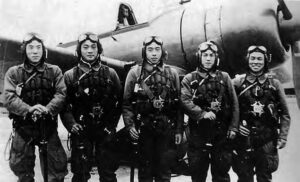
In the first battles of the war in the Solomons and New Guinea, GIs learned that a Japanese soldier’s surrender attempt might actually be a ruse designed to take an American with him on his journey into death. These early hostilities helped create a kind of battlefield culture in the Pacific, and the events described became lessons learned for soldiers trained later in the war. More importantly, soldiers transmitted these accounts to each other. The rumor mill works overtime in war, and bogus or exaggerated accounts of Japanese treachery circulated. Later in the war, politically indoctrinated American GIs did arrive and quickly believed the worst stories. Sadly, as the war progressed and the bloom of Japan’s early victories disappeared, it is possible that more imperial troops might have been willing to surrender had the situation allowed it. However, Americans were increasingly convinced that the Japanese would not surrender or that a surrender offer might prove a ruse, so taking prisoners was considered not worth the risk. Japanese propaganda told soldiers and civilians that Americans were butchers who would murder anyone who was tempted to capitulate. By 1944, both sides were preaching a kind of truth.
A tragedy took place in the South Pacific that stemmed largely from the grotesque manipulation of the Japanese people by the military government. By successfully convincing their soldiers to find meaning in oblivion and to accept the frightening idea that spiritual purification comes through purposeful death, the Japanese government created the psychological framework for total war. I think that it is very possible that the well-earned image of Japan as a fanatical, even suicidal, foe had a profound influence on the extremely brutal measures taken by the US to end the Pacific War.
FURTHER READING
Asada, Sadao. From Mahan to Pearl Harbor: The Imperial Japanese Navy and the United States. Annapolis, MD: US Naval Institute Press, 2006.
Bergerud, Eric M. Touched with Fire: Land War in the South Pacific. New York: Penguin Books, 1997.
Bix, Herbert P. Hirohito and the Making of Modern Japan. New York: Harper Perennial, 2001.
Dalleck, Robert. Franklin D. Roosevelt and American Foreign Policy, 1932–1945. New York: Oxford University Press, 1981.
Miller, Edward S. War Plan Orange: The US Strategy to Defeat Japan, 1897–1945. Annapolis, MD: US Naval Institute Press, 2007

